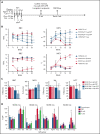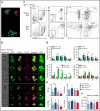Studies of a mosaic patient with DBA and chimeric mice reveal erythroid cell-extrinsic contributions to erythropoiesis
- PMID: 35349664
- PMCID: PMC9185154
- DOI: 10.1182/blood.2021013507
Studies of a mosaic patient with DBA and chimeric mice reveal erythroid cell-extrinsic contributions to erythropoiesis
Abstract
We follow a patient with Diamond-Blackfan anemia (DBA) mosaic for a pathogenic RPS19 haploinsufficiency mutation with persistent transfusion-dependent anemia. Her anemia remitted on eltrombopag (EPAG), but surprisingly, mosaicism was unchanged, suggesting that both mutant and normal cells responded. When EPAG was withheld, her anemia returned. In addition to expanding hematopoietic stem/progenitor cells, EPAG aggressively chelates iron. Because DBA anemia, at least in part, results from excessive intracellular heme leading to ferroptotic cell death, we hypothesized that the excess heme accumulating in ribosomal protein-deficient erythroid precursors inhibited the growth of adjacent genetically normal precursors, and that the efficacy of EPAG reflected its ability to chelate iron, limit heme synthesis, and thus limit toxicity in both mutant and normal cells. To test this, we studied Rpl11 haploinsufficient (DBA) mice and mice chimeric for the cytoplasmic heme export protein, FLVCR. Flvcr1-deleted mice have severe anemia, resembling DBA. Mice transplanted with ratios of DBA to wild-type marrow cells of 50:50 are anemic, like our DBA patient. In contrast, mice transplanted with Flvcr1-deleted (unable to export heme) and wild-type marrow cells at ratios of 50:50 or 80:20 have normal numbers of red cells. Additional studies suggest that heme exported from DBA erythroid cells might impede the nurse cell function of central macrophages of erythroblastic islands to impair the maturation of genetically normal coadherent erythroid cells. These findings have implications for the gene therapy of DBA and may provide insights into why del(5q) myelodysplastic syndrome patients are anemic despite being mosaic for chromosome 5q deletion and loss of RPS14.
© 2022 by The American Society of Hematology.
Figures






Comment in
-
Defending the island against excess heme.Blood. 2022 Jun 9;139(23):3359-3360. doi: 10.1182/blood.2022016341. Blood. 2022. PMID: 35679077 Free PMC article. No abstract available.
Similar articles
-
Eltrombopag Improves Erythroid Differentiation in a Human Induced Pluripotent Stem Cell Model of Diamond Blackfan Anemia.Cells. 2021 Mar 26;10(4):734. doi: 10.3390/cells10040734. Cells. 2021. PMID: 33810313 Free PMC article.
-
Regulation of globin-heme balance in Diamond-Blackfan anemia by HSP70/GATA1.Blood. 2019 Mar 21;133(12):1358-1370. doi: 10.1182/blood-2018-09-875674. Epub 2019 Jan 30. Blood. 2019. PMID: 30700418 Free PMC article.
-
Delayed globin synthesis leads to excess heme and the macrocytic anemia of Diamond Blackfan anemia and del(5q) myelodysplastic syndrome.Sci Transl Med. 2016 May 11;8(338):338ra67. doi: 10.1126/scitranslmed.aaf3006. Sci Transl Med. 2016. PMID: 27169803 Free PMC article.
-
Activation of the mTOR pathway by the amino acid (L)-leucine in the 5q- syndrome and other ribosomopathies.Adv Biol Regul. 2013 Jan;53(1):8-17. doi: 10.1016/j.jbior.2012.09.002. Epub 2012 Sep 13. Adv Biol Regul. 2013. PMID: 23031788 Review.
-
Molecular pathogenesis in Diamond-Blackfan anemia.Int J Hematol. 2010 Oct;92(3):413-8. doi: 10.1007/s12185-010-0693-7. Epub 2010 Sep 30. Int J Hematol. 2010. PMID: 20882441 Review.
Cited by
-
Polysome profiling is an extensible tool for the analysis of bulk protein synthesis, ribosome biogenesis, and the specific steps in translation.Mol Biol Cell. 2025 Apr 1;36(4):mr2. doi: 10.1091/mbc.E24-08-0341. Epub 2025 Mar 5. Mol Biol Cell. 2025. PMID: 40042939 Free PMC article.
-
Unearthing FLVCR1a: tracing the path to a vital cellular transporter.Cell Mol Life Sci. 2024 Apr 6;81(1):166. doi: 10.1007/s00018-024-05205-3. Cell Mol Life Sci. 2024. PMID: 38581583 Free PMC article. Review.
-
Treatment of refractory/relapsed Diamond-Blackfan anaemia with eltrombopag.Br J Haematol. 2024 May;204(5):2077-2085. doi: 10.1111/bjh.19357. Epub 2024 Mar 10. Br J Haematol. 2024. PMID: 38462764 Free PMC article. Clinical Trial.
-
Transfusion avoidance in myelodysplastic neoplasms.Curr Opin Hematol. 2024 Mar 1;31(2):40-46. doi: 10.1097/MOH.0000000000000794. Epub 2023 Nov 16. Curr Opin Hematol. 2024. PMID: 37982261 Free PMC article. Review.
-
TFPI from erythroblasts drives heme production in central macrophages promoting erythropoiesis in polycythemia.Nat Commun. 2024 May 10;15(1):3976. doi: 10.1038/s41467-024-48328-8. Nat Commun. 2024. PMID: 38729948 Free PMC article.
References
Publication types
MeSH terms
Substances
Grants and funding
LinkOut - more resources
Full Text Sources
Medical
Miscellaneous

